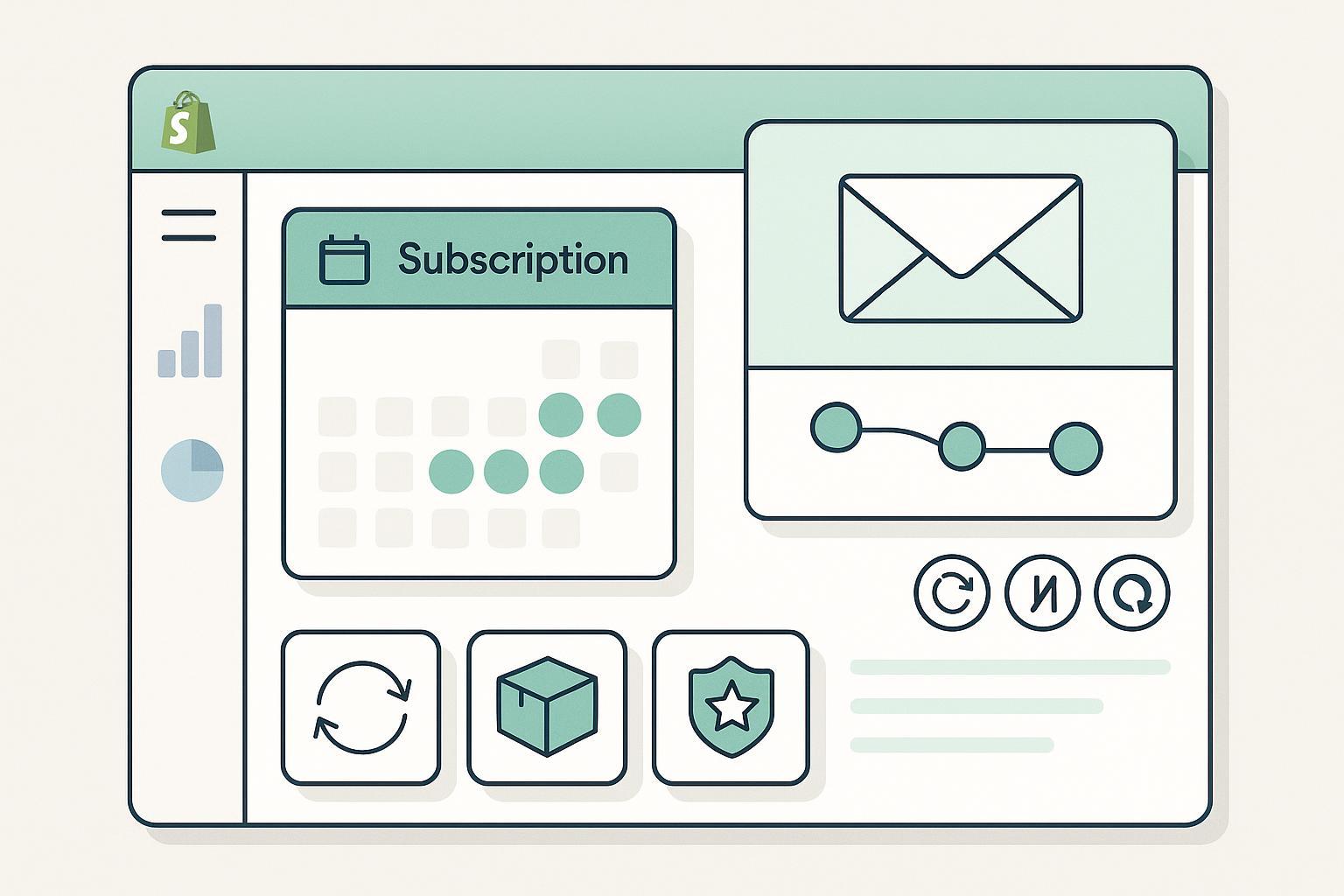What Is Subscription Ecommerce and Why Email Matters for Shopify Brands

Subscription ecommerce is a retail model where customers pay on a recurring schedule—monthly, quarterly, or annually—to receive goods or services, creating predictable revenue and longer customer relationships. In Shopify’s ecosystem, this typically shows up as “purchase options” at checkout tied to subscription contracts and customer portals for pause/skip/cancel management, as outlined in the Shopify Enterprise overview of ecommerce subscriptions (2024) Shopify explains the core models and why brands adopt them.
What subscription ecommerce is (and isn’t)
At its core, a subscription turns one-off orders into a repeat relationship.
Common model patterns you’ll see on Shopify:
- Replenishment (auto‑refill). Examples: coffee, supplements, pet food. The value is convenience and savings.
- Curation (discovery boxes). Examples: beauty boxes or themed kits. The value is surprise and personalization.
- Access/Membership (perks). Examples: free shipping, exclusive drops, members‑only pricing. The value is benefits and status.
Reality is often hybrid: many brands combine “subscribe‑and‑save” replenishment with members‑only perks. Stripe’s primer emphasizes subscriptions as a way to turn transactions into recurring income while offering flexible plans and billing cadences Stripe’s subscription models overview.
What it isn’t:
- Not just a loyalty program or coupon—there must be a recurring billing agreement.
- Not limited to software—physical goods dominate on Shopify.
Why email matters so much for subscription brands
Unlike standard ecommerce, subscriptions create predictable “moments of influence” around each renewal: pre‑charge notifications, pause/skip decisions, SKU swaps for curated boxes, and payment failures (dunning). Well‑timed, automated emails meet customers exactly at those moments.
Two data points frame the opportunity as of 2025:
- Automated emails consistently outperform batch campaigns on engagement and revenue contribution across very large datasets, according to the Omnisend 2025 ecommerce marketing report analyzing 24B emails automations materially outperform one‑off campaigns.
- Payment recovery and churn mitigation are central to subscription growth. The Recurly State of Subscriptions 2025 resources highlight failed‑payment risk and the outsized impact of recovery tactics Recurly 2025 report hub and trends.
In practical terms, that means email should anchor your retention program, with triggered messages for onboarding, pre‑renewal, pause/skip, cross‑sell/upgrade, failed payments, and win‑back.
The KPIs that matter (and how email touches them)
- Churn rate (voluntary vs. involuntary). Voluntary churn is when customers actively cancel; involuntary is payment failure. Email supports save offers, pause/skip alternatives, and dunning sequences to reduce both.
- Retention/renewal rate. The flip side of churn—how many subscribers renew on each cycle. Pre‑renewal reminders and “edit your next order” emails support retention.
- Lifetime value (LTV). The total gross margin or revenue a subscriber generates over their tenure. Onboarding, replenishment reminders, and cross‑sell messages tend to lift LTV by increasing order count and AOV.
- Average revenue per user (ARPU). Averages revenue across active subscribers; email‑driven upgrades (bigger bag size, higher‑tier plan) can raise ARPU.
Benchmark note: engagement and churn vary widely by vertical and offer. Klaviyo’s 2025 analyses show typical ecommerce open rates often in the 20–30% range and click rates in the low single digits, with automations outperforming campaigns Klaviyo 2025 benchmark overview. Use ranges as a directional guide, not absolute targets.
A lifecycle email program mapped to Shopify/Klaviyo triggers
Below are the core flows most subscription brands implement first. Triggers and data conditions can be configured with Shopify’s native events, subscription app data, and Klaviyo/Shopify Flow connectors.
- Onboarding/welcome (right after signup)
- Trigger: New subscription created or first subscription order placed.
- Timing: Immediate, then a follow‑up 2–3 days later.
- What to include: How to manage deliveries (pause/skip), how to swap SKUs, first‑order expectations.
- Copy idea: “You’re in. Here’s how to control your next delivery in two clicks.”
- Pre‑renewal/upcoming order reminder
- Trigger: X days before next charge (commonly 3–7 days), based on subscription contract renewal date.
- Timing: 1–2 emails leading up to charge; include a same‑day SMS if opted‑in.
- What to include: Edit options (size/flavor), skip/pause links, shipping cutoffs.
- Copy idea: “Your next roast ships Friday—change beans, skip, or pause by Thursday.”
- Replenishment reminder
- Trigger: Days‑since‑fulfillment or predicted consumption window for consumables.
- Timing: 20–30 days after last delivery (category‑dependent).
- What to include: Quick re‑order, adjust cadence, or move to subscription if still one‑time.
- Pause/skip nudges
- Trigger: When a subscriber clicks “pause/skip” or shows churn‑risk behaviors (e.g., streak of early skips).
- Timing: Real‑time confirmation + a helpful follow‑up with alternatives.
- What to include: Cadence options (every 6 vs 4 weeks), smaller sizes, or delayed next charge.
- Upgrade/cross‑sell
- Trigger: After 2–3 successful renewals or high satisfaction signals.
- Timing: Post‑delivery; avoid crowding the pre‑renewal window.
- What to include: Larger size, premium tier, complementary add‑ons.
- Failed payment (dunning)
- Trigger: Payment failure on renewal attempt.
- Timing: Immediate notification, then 2–3 reminders over 3–7 days before cancellation.
- What to include: One‑click payment update, alternate method, assurance of order hold window.
- Copy idea: “We saved your order. Update your card securely to ship.”
- Cancellation save + survey
- Trigger: Cancel action.
- Timing: Confirm immediately; follow with a brief survey and tailored save offer (pause, smaller plan, different product).
- Win‑back (post‑cancel)
- Trigger: 30–60 days after cancellation with no reactivation.
- Timing: 1–2 messages with a clear reason to return (new SKU, improved formula, limited perks), then sunset if no engagement.
Implementation tip: Many of these flows use standard Shopify and Klaviyo events, though some subscription‑specific triggers require app webhooks, Shopify Flow, or segment conditions rather than a single “subscription event.” Klaviyo documents the core Shopify data sync and flow triggers you’ll rely on Klaviyo’s Shopify integration and events.
A practical Shopify workflow example: attributing renewal revenue from lifecycle emails
Imagine a coffee subscription brand on Shopify. You send a pre‑renewal email 5 days before billing and a dunning email if the card fails. How do you trace which renewals were influenced by those emails?
- First, add UTM parameters and a subscriber ID to your email links to the customer portal (manage, pause, update payment) and to “edit upcoming order” pages.
- When a subscriber clicks, your analytics should capture a server‑side event that stitches the email touch to the eventual renewal order—even if the final charge posts hours later.
- If the payment initially fails, your dunning email links should carry the same parameters to connect the successful retry to the prior email touch.
In practice, platforms like Attribuly can capture these server‑side events and tie Klaviyo email clicks to renewal conversions without relying solely on last‑click cookies. Disclosure: Attribuly is our product. For setup specifics, see the internal resources: Getting started with Attribuly (server‑side tracking and parameters) and the Attribuly ↔ Klaviyo integration overview.
Compliance and deliverability basics (don’t skip this)
- Clear terms, consent, easy cancel (U.S.). The FTC’s Enforcement Policy Statement on negative‑option/subscription offers (Oct 2021) requires clear, conspicuous disclosure before billing info, express informed consent, and a cancellation method at least as easy as signup FTC negative option policy statement PDF. Recent FTC actions in 2024–2025 further underline enforcement—make cancellation simple.
- Authenticate your domain and protect sender reputation. Set up SPF, DKIM, and DMARC; send consistently; and segment to engaged users. Shopify’s deliverability guidance (2025) offers a practical checklist for merchants Shopify’s email deliverability best practices.
- Maintain list hygiene and consent. Use (double) opt‑in, remove hard bounces, and sunset long‑term inactives.
Troubleshooting FAQ for Shopify subscription emails
-
Our pre‑renewal emails have low opens. What should we change?
- Check deliverability (SPF/DKIM/DMARC), prune unengaged segments, and tighten subject lines to the job (“Your order ships Friday—edit or skip by Thursday”). Benchmark engagement using ranges like those summarized by Klaviyo in 2025 to set realistic goals Klaviyo’s 2025 benchmark overview.
-
Dunning emails aren’t recovering payments.
- Send immediately on failure, add 2–3 reminders over 3–7 days, and include one‑click payment update links. Offer alternate methods if available. Recurly’s 2025 emphasis on payment recovery highlights how crucial this window is Recurly 2025 trends and benchmarks.
-
High month‑1 churn after trials or discounts.
- Improve onboarding: set delivery expectations, reinforce value, and preview what’s next. Add a pre‑renewal tip (“customize your next box”) and a pause option to reduce knee‑jerk cancels.
-
We can’t trigger flows on subscription events.
- Use Shopify Flow plus your subscription app’s webhooks to write customer properties or events, then trigger or filter Klaviyo flows. Many brands also target subscribers by segment rules (e.g., last order contained a subscription item) and renewal date logic.
-
Customers say cancel is hard to find.
- Add clear links in the customer portal and in emails. The FTC standard requires a cancellation path at least as easy as signup; violations are an enforcement risk in 2025.
Putting it all together
If you run subscriptions on Shopify, start with the eight lifecycle flows above and layer in simple, compliant experiences: transparent terms, easy cancel, authenticated email, and clean data. Use server‑side tracking to attribute renewals influenced by email, especially around pre‑renewal and dunning windows, and calibrate your goals with current industry ranges from reputable sources like Omnisend and Klaviyo.
Optional next step: If you need to connect lifecycle emails to subscription revenue without relying on last‑click cookies, consider testing a neutral analytics layer that ties Klaviyo events to Shopify renewals via server‑side tracking, such as Attribuly.
—
Citations note: External facts and definitions are current as of 2025-10-15 and drawn from Shopify (subscriptions overview), Stripe (model typology), Recurly (2025 report hub), Omnisend (2025 report), Klaviyo (2025 benchmarks), the FTC (negative option policy), and Shopify’s deliverability guidance.
